Nauvari Saree is also recognized as Lugade, Kacha, Navvari saree, Kashta saree, and Sakacha. Primarily, it is a traditional nine-yard saree wrapped by females in mostly in Maharashtra region.
Readymade Nauvari saree in Pune have mixed techniques of draping as new techniques have been evolving and people from advanced era admires it so much. This Readymade nauvari saree in Pune can be carried externally without a petticoat as old technique nauvari sarees.
The fashion of drape for Nauvari has emerged drastically from the classical form to the modern-age following and is dressed in such a form that it provides a trouser-dress like an expression, while the saree is tucked at the back. Nauvari sarees normally come in cotton and is worn out without a Petticoat, majorly by the Maharashtrian Brahmin women community.

The Nauvari saree is customarily worn by the venerable Marathi females and the Maharashtrian Brahmin ladies. With a harmonious lifestyle and absolute beauty of the Marathi women, Nauvari is usually accessorized with classical gold jewelry and gajra in the hair.
The uniqueness to this peculiarity is that it is comfortable to wear, charming looking and gives a very satisfying feeling, unlike the initial draping. This shift has brought it a global demand and has made it readily available by all. It is performed in such a fashion that it drapes one’s size and no one ever understands that it is truly a stitched saree.
Nauvari Saree History, Material, Types, Specialty and Popularity
Let’s see more details about Nauvari saree history, material used, the specialty, the places where is Nauvari saree popular and for what occasions Nauvari saree is preferred etc.
Nauvari Saree history

Historically, the ladies of the Maratha Empire showcased their skills and ability by helping their fellow masculine heroes during periods of war. Therefore, in order to fulfill their purpose and yet persevere in their support of physical movement throughout the wars, these Marathi women discovered this Maharashtrian fashion of drape.
The Nauvari saree brings home, an inherent honesty that a woman, a loving person who is normally known as the home keeper can also be the savior of humankind when required.
Nauvari Saree Material

The Nauvari sarees are available in various categories and patterns. Originally, they were produced from cotton, but now they are readily accessible in other textiles as well, including silk and satin. These conventional nauvari sarees are decorated with beautiful floral prints and are elegantly composed with motifs and decorations. One can complement this saree with 3/4th sheaths or even sleeveless tops to create a striking fusion look.
Over the times, the Pano bhaju, Nauvari saree, and the vakal have maintained their dignity in contempt of the developing style trends and lifestyle. The Nauvari Sarees have seen a transition from Cotton textiles to Silks. The sarees have also observed a shift in the tone and the decoration; from variations of blue and green to vivid colors of yellow, red, pink, and sometimes hues of pastel grey, bluish-red and gold gives it the summertime look and are more in sync with the contemporary modernist day style.
The embellishment has witnessed a swift soberness and is limited to short segments of the cloth. The latest pre-formed saree, the Trench-Kurta, a lehenga coupled with a somewhat intriguing jeweled neck article and a top, creative and chic ruffles or frills as emphases, a beautiful lungi skirt surround the inspirational take on this artistic ensemble.
Nauvari Saree Types
Peshawari Nauvari Saree
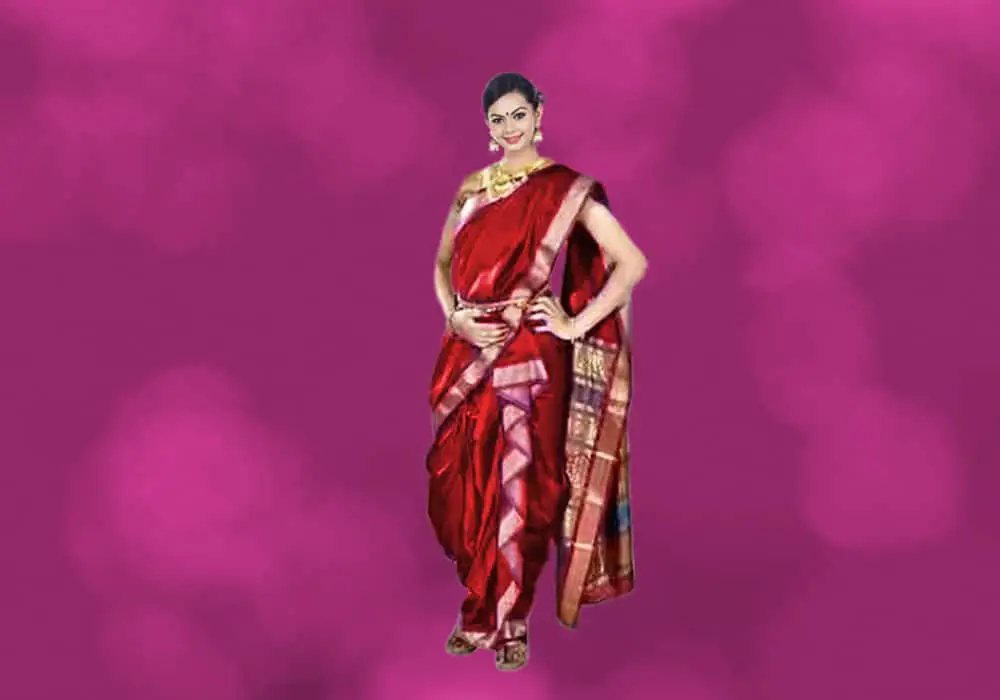
Peshwarai nauvari saree is also popularly known as the gajaki. Peshawari nauvari sarees are famous in Maharashtra. The remarkable sarees are a staple for all the ladies around the world and they can be worn in various fashions.
But, the most common style of wearing the saree is the zigzag fashion. They are available in a variety of colors and can be worn for varied events. Additionally, one can consider the saree as a bridal saree too as it is available in the very form also.
Brahmani Nauvari Saree

These sarees originally worn by the Brahmins are very elegant and beautiful, hence it got the name as Brahmani nauvari saree. It is a typical Maharashtrian Fashion which came to the rest of the nation during the ancient days when women warriors used to wear this saree before going to the battleground.
Brahmani nauvari sarees are mainly available in Silk and popular across India and all over the world. People from various nations have a thing for this kind of sarees and the market is also flourishing these days due to the craze among women. They are mostly available in readymade forms.
Traditional Maharashtrian Nauvari Saree
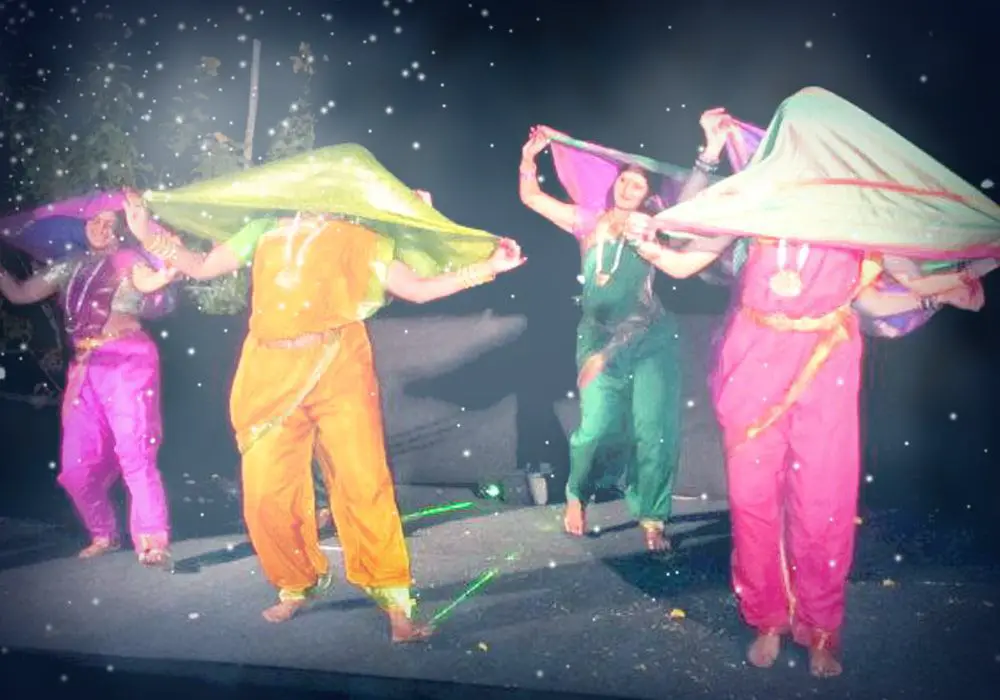
The Traditional Maharashtrian Nauvari saree is actually worn by women without a petticoat and it looks like a man’s dhoti or more accurately you can call it as wrapped pants due to way it looks.
The bottom portion with the Maharashtrian nauvari saree pallu is used by women to cover the bust. Other than the usual 5-6 meters regular nauvari saree, the traditional Maharashtrian Nauvari saree is 8-9 meters in length.
Specialty of Nauvari Saree

Artists like Julie Bendkhale of Zuilee, Nachiket Barve, Vaishali Shandangule have initiated mighty style statements for Indian style on the ramp and their composition is greatly inspired by the history and classical attire of the country, including the excellent and uncommon Nauvari sarees.
Substituting the conventional textile from cotton material to silk in these sarees has produced in it a grand look. For the travelers, it is a necessity to have a token from the motherland. Numerous Indian actresses have embellished this nauvari saree at global events and have acclaimed applauds which makes nauvari saree very special.
Popular places for Nauvari Saree
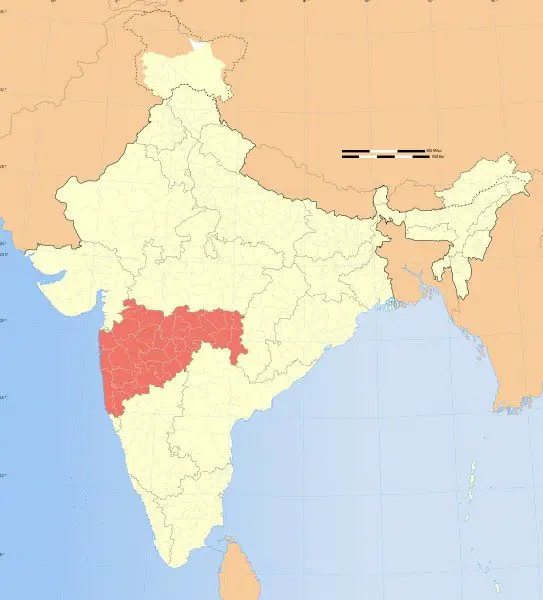
Nauvari sarees are primarily popular in the Maharashtrian region. People from Pune and all other parts of Maharashtra mainly favour this saree. Especially, when it comes to ladies. This saree is also available in other parts of India other than Maharashtra. But, it’s greatly available in the state of Maharashtra as it is the the initial origin of the specific outfit.
Women from all other parts of India and the world can purchase this saree from any top saree selling store but it will be the best ever option to fly down to Maharashtra and buy the saree as there will be no chance of fakeness. Other regions sell fake sarees and materials. Therefore, the excellent choice is the get one from the ancestors. Its most popular among the people out there in Maharashtra.
Nauvari saree for festivals, functions and occasions

The popular ‘nauvari’ holds its appeal even in the advanced age. Also recognized as ‘Lugada’, this saree is now typically carried often by aged Maharashtrian women. Still, in the up-to-date trend, the bias of wearing nine-yard Kasta sari is pulling up wild in the modern lot that craves to hold the age-old Marathi ritual alive. It requires excellent technique, tradition, and completeness to wear a nine-yard saree. Frequently worn in dancing competitions, “lavani” and Maharashtrian folk dance, the Kasta saree has clearly made a grand come back in the convention industry.
The Nauvari saree is a beautiful attire that is frequently worn by the Maharashtrian wives for their marriage functions. It is typically wrapped in a classical technique that makes the brides resemble sumptuous and sophisticated. You can observe numerous women carrying Nauvari sarees throughout important celebrations such as Ganesh Chaturthi and Gudi Padwa in Maharashtra.
People transversely throughout India are totally absorbed in the pleasant spirit of Ganesh Chaturthi. They have already established the avatars of Lord Ganesha in their houses, synagogues, and pandals amidst the deafening choruses of “Ganapati Bappa Morya”. Particularly in Maharashtra, this favorable happening is commemorated on a grand scale with a lot of intensity and enthusiasm.
You will notice the maximum of Marathi women groomed in their conventional attires, usually known as ‘Nauvari’. Finely attired in their conventional sarees along with some beautiful gold embellishments, these women commemorate the festival of their beloved God with enthusiasm and commitment.
How to wear Nauvari Saree

This saree is modeled in a fashion that the middle of the saree is neatly arranged at the edge of the waist and the tops of the saree are bound securely in the foreground, and then the two edges are sheathed around the legs.
The ornamental ends are then wrapped over the arm and the top body or trunk. Sayali Badade, an HR executive told, “A woman who carried a Nauvari was always viewed in with honor. The purpose is both the arms of the ladies are closed, and it goes for a quite acceptable wear.
The method was incipiently incited and spread from the Peshwai reign” Here are the ways how the different types of nauvari sarees are worn step by step.
Traditional Nauvari Saree – How to Wear Step by Step
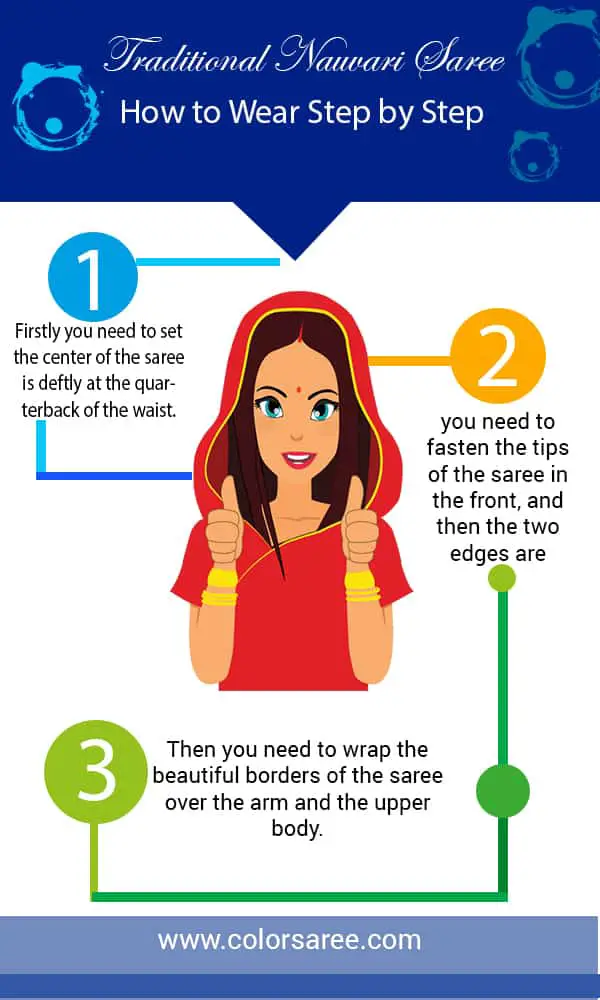
The classical style of drape motivated by the fighter Marathi ladies is used without a petticoat. The drape includes the successive steps:
Step 1:
Firstly you need to set the center of the saree is deftly at the quarterback of the waist.
Step 2:
Then after the last step you need to fasten the tips of the saree in the front, and then the two edges are covered around the limbs, transmitting a trouser-like look.
Step 3:
Then you need to wrap the beautiful borders of the saree over the arm and the upper body.
The draping of this saree does not stop here and travels down south to Goa- the land of seamen and shores. The conventional clothes of the fisher-women of Goa is an alteration to the Nauvari Sari – Pano Bhaju’. The ladies cover this up in brilliant and energetic shades and draw it up with Vakal which is a chain of beads with sheath loincloths wrapped around the neck.
Koli Drape – How to Wear Step by Step

The Koli community comprises characters who emigrated from Himachal Pradesh, Gujarat, Rajasthan, Maharashtra, Uttar Pradesh, and Haryana, to the state of Maharashtra. The matrons of this society wear Nauvari in two pieces. The Koli saree draping process includes the following steps:
Step 1:
In this case, the Nauvari saree is first split into two different pieces.
Step 2:
Now you need to start inserting the parts of the saree in the waist. Firstly, you need to stick one part and firmly attach it around the waist.
Step 3:
Then, the other portion is firmly tucked at the uppermost section of the body keeping the stability in mind and then extracted over the head through the left arm, to give a Marathi look. This is the perfect Koli style draping of the Nauvari saree.
Nauvari Saree Price
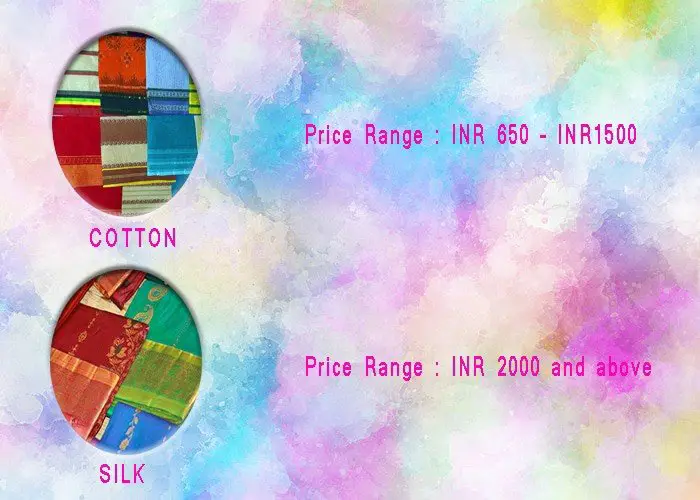
The price range of Nauvari sarees varies from saree to saree as well as material to material. On one hand, cotton sarees are cheap and affordable but on the other hand, silk and some other saree materials may cost a little higher in range.
Starting from around INR 600, Nauvari sarees can cost up to INR 5000 or even more. Cotton Nauvari saree starts from INR 650 to almost INR 1500.
Whereas, if you want to dress up for a special occasion, silk sarees are a must option. Every traditional festival is incomplete without a silk saree. Silk sarees start from INR 2000 and so on.
Latest Nauvari Saree Designs

List of latest Nauvari saree designs
- Shahi Mastani
- Shahi Brahmani
- Mhalsa
- Apsara
- Devsena
- Devyani
- Peshwai Brahmani
- Kolhapuri
- Kadambari
- Bharatanatyam
- Lavni
- Triveni
- Mastani
- Koli
- Marathmoli
- Fulwanti
Above-mentioned are some of the latest designs of Nauvari sarees which are fancied among all Indian women as a traditional outfit. These are worn by all Indian women especially Maharashtrians during Ganesh Chaturthi. They favor this attire as a special one during the auspicious festival of Ganesh Chaturthi. Moreover, it is in the tradition itself.







